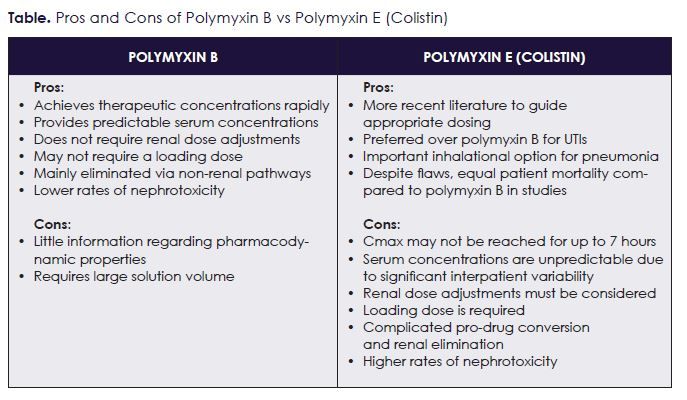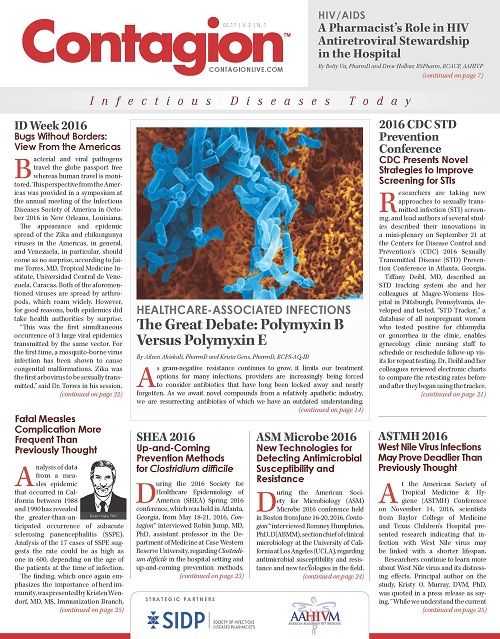The Great Debate: Polymyxin B Versus Polymyxin E
As we await novel compounds from a relatively apathetic industry, we are resurrecting antibiotics of which we have an outdated understanding. and that carry the potential for substantial side effects: polymyxins.
In the War on Antibiotic Resistance, There May Be No Clear Winner
As gram-negative resistance continues to grow, it limits our treatment options for many infections, and providers are increasingly being forced to consider antibiotics that have long been locked away and nearly forgotten. As we await novel compounds from a relatively apathetic industry, we are resurrecting antibiotics of which we have an outdated understanding. and that carry the potential for substantial side effects: polymyxins.
To further complicate matters, there is an intriguing debate developing within the infectious diseases arena: the use of polymyxin B versus polymyxin E (colistin). Colistin has been called into question as a drug of choice for multi-drug resistant (MDR) infections, while a recent spotlight on polymyxin B is bringing it back onto the MDR treatment stage. Colistin’s historically unattractive properties have incentivized providers to reevaluate other potential options, reopening the door for polymyxin B with its potentially more appealing profile. Many clinicians are aware of colistin’s nephrotoxity and the ambiguity surrounding dosing, particularly in renal insufficiency, but most are largely unfamiliar with polymyxin B. We start the debate by delineating the benefits of polymyxin B and follow it up with an explanation of why hospitals continue to use colistin.
TEAM POLYMYXIN B
Although structurally similar to colistin, polymyxin B offers multiple pharmacokinetic advantages in the treatment of systemic infections. Polymyxin B achieves therapeutic concentrations rapidly, provides more predictable serum concentrations, does not require renal dose adjustments and may not require a loading dose. In comparison, colistin’s peak serum concentration may not be reached for up to 7 hours, serum concentrations are unpredictable due to significant interpatient variability, renal dose adjustments must be considered, and a loading dose is required.
What accounts for these prominent differences in two structurally similar drugs? Colistin is administered as an inactive prodrug, colistimethate (CMS), while polymyxin B is already in its active form. In patients with moderate to good renal function, studies suggest only 20% to 25% of CMS is converted to its active form, with the majority of the dose being renally excreted prior to conversion.1 Because of this, larger doses of CMS are required to achieve therapeutic systemic colistin concentrations. Polymyxin B is mainly eliminated via nonrenal pathways, accounting for little interpatient variability across a wide range of creatinine clearance, whereas CMS clearance is variable even at a given creatinine clearance (eg, two patients with the same creatinine clearance will clear CMS at different rates). Although nephrotoxicity has been a point of contention, recent studies have found lower rates of nephrotoxicity with polymyxin B compared with colistin.2,3 The need for higher doses and extensive renal excretion of CMS leading to increased renal exposure have been offered as the rationale for this difference.
A recent study assessing the pharmacokinetic differences on bacterial killing and resistance emergence in Acinetobacter baumanii found that rapid attainment of target concentrations was critical for polymyxin-induced bacterial killing.4 The gradual rise in colistin concentrations lead to faster development of polymyxin resistance, contributing to little bacterial killing over the treatment period. Conversely, polymyxin B demonstrated good early bacterial killing, which the authors attributed to rapid attainment of bactericidal concentrations that overtook the onset of polymyxin resistance. However, resistance eventually developed following treatment with either agent, despite significant differences in the magnitude of bacterial killing. This supports the importance of using both polymyxins only in combination with additional antibiotics and (almost) never as monotherapy.
TEAM POLYMYXIN E
Although polymyxin B can seem like a very appealing alternative, little literature is available detailing the pharmacokinetics of polymyxin B, and there is a dearth of information regarding its pharmacodynamic properties. What we do know from five clinical trials comparing colistin and polymyxin B treatment is there is no difference in mortality.2,3,5-7 In addition, there are particular diseases states where colistin is likely preferred. Colistin is readily converted to its active form in urine and therefore reaches superior urinary concentrations compared with polymyxin B.1 Less than 1% of polymyxin B is recoverable in urine.8 Another benefit of colistin is its ability to be administered via inhalation. Inhalational colistin is currently recommended by the Infectious Diseases Society of America for treatment of hospital acquired- and ventilator associated pneumonia with multi-drug resistant infections.9 Finally, admixtures of polymyxin B require a considerable amount of solution volume, which may make colistin more appealing for those that cannot handle the extra fluid. Depending on patient weight, volumes of 500 to 1000 mL per dose (typically given twice daily) are not uncommon.
Although dosing of colistin is ambiguous at best and an unfortunate amount of interpatient variability exists, a considerable quantity of recent literature has been published to help clarify this issue. A recent study determined that a steady-state concentration of 2 mg/L should meet our targets.10 This study also identified that concentrations greater than 2 mg/L lead to increased incidence and severity of acute kidney injury.10 In addition, studies have suggested no benefit to more aggressive dosing,11 so in the future, it may be possible for us to be able to optimize colistin dosing. Whereas appropriate dosing, especially in renal insufficiency, is still a considerable barrier and a reason why many contemplate polymyxin B, recent literature has at least been able to guide us in the direction of using a 5-mg/kg loading dose and to strongly consider using ideal body weight.12 In addition, a potential scoring system is available to help identify patients most at risk for nephrotoxicity, which may help us customize our dosing in high-risk patients.13
CONCLUSION
As rampant antibiotic resistance continues to diminish our treatment options, we are more frequently forced to utilize the broadest spectrum and more toxic antibiotics. Recent reports from China documented the emergence of plasmid-mediated colistin resistance (MCR-1),14 and as of November 30, 2016, there have been human isolates of MCR-1 gene—containing organisms in Connecticut, Maryland, New Jersey, New York, and Pennsylvania.15 Animal isolates have also been found in Illinois and South Carolina.15
Optimization of antimicrobial therapy is the fundamental premise in slowing the unavoidable propagation of resistance. Thus, it is imperative to use and dose our polymyxins appropriately. Polymyxin B discernably wins the nephrotoxicity battle and is not a prodrug; administering its active form enables reliable dosing regardless of renal dysfunction and rapid achievement of therapeutic concentrations. However, despite polymyxin B’s multiple benefits, colistin certainly should not be disregarded. Superior urinary concentrations and the ability to administer via inhalation are undoubtedly some of colistin’s strong points. Additionally, more literature has been published that is enabling us to better understand how to appropriately and safely dose colistin.
So, which polymyxin do we choose? As with all clinical conundrums, there is no easy answer and the intellectual debate rages on. Thankfully, new literature on these old drugs continues to be published, and we will undoubtedly further our understanding of these unique antibiotics in the coming years.
A quick breakdown of the pros vs cons of the two polymyxins appears at the end of this article (see Table).

Krista Gens, PharmD, BCPS-AQ ID is in infectious diseases clinical coordinator at Abbott Northwestern Hospital, Minneapolis, MN, where she helps maintain antimicrobial stewardship programs at Abbott Northwestern and at several Allina Health regional hospitals. She is an active member of ACCP, ASHP, and SIDP.
Aileen Ahiskali, PharmD, is an infectious diseases pharmacist and antimicrobial stewardship program coordinator at Hennepin County Medical Center in Minneapolis, MN, where she coordinates antimicrobial stewardship initiatives and rounds with the infectious diseases team daily.
References:
- Couet W, Grégoire N, Gobin P, et al. Pharmacokinetics of colistin and colistimethate sodium after a single 80-mg intravenous dose of CMS in young healthy volunteers. Clin Pharmacol Ther. 2011;89(6):875-879.
- Phe K, Lee Y, McDaneld PM, et al. In vitro assessment and multicenter cohort study of comparative nephrotoxicity rates associated with colistimethate versus polymyxin B therapy. Antimicrob Agents Chemother. 2014;58(5):2740-2746.
- Akajagbor DS, Wilson SL, Shere-Wolfe KD, Dakum P, Charurat ME, Gilliam BL. Higher incidence of acute kidney injury with intravenous colistimethate sodium compared with polymyxin B in critically ill patients at a tertiary care medical center. Clin Infect Dis. 2013;57(9):1300-1303.
- Cheah SE, Li J, Tsuji BT, Forrest A, Bulitta JB, Nation RL. Colistin and polymyxin B dosage regimens against Acinetobacter baumannii: differences in activity and the emergence of resistance. Antimicrob Agents Chemother. 2016;60(7):3921-3933.
- Oliveira MS, Prado GV, Costa SF, Grinbaum RS, Levin AS. Polymyxin B and colistimethate are comparable as to efficacy and renal toxicity. Diagnostic Microbiol Infect Dis. 2009;65(4):431-434.
- Phe K, Lee Y, McDaneld PM, et al. In vitro assessment and multicenter cohort study of comparative nephrotoxicity rates associated with colistimethate versus polymyxin B therapy. Antimicrob Agents Chemother. 2014;58:2740-2746.
- Rigatto MH, Oliveira MS, Perdiago-Neto LV, et al. Multicenter prospective cohort study of renal failure in patients treated with colistin versus polymyxin B. Antimicrob Agents Chemother. 2016;60(4):2443-2449.
- Zavascki AP, Goldani LZ, Cao G, et al. Pharmacokinetics of intravenous polymyxin B in critically ill patients. Clin Infect Dis. 2008;47(10):1298-1304.
- Kalil AC, Metersky, ML, Klompas M, et al. Management of adults with hospital-acquired and ventilator-associated pneumonia: 2016 clinical practice guidelines by the Infectious Diseases Society of America and the American Thoracic Society. Clin Infect Dis. 2016;63(5):e61-e111.
- Cheah SE, Wang J, Nguyen VT, Turnidge JD, Li J, Nation RL. New pharmacokinetic/pharmacodynamic studies of systemically administered colistin against Pseudomonas aeruginosa and Acinetobacter baumannii in mouse thigh and lung infection models: smaller response in lung infection. J Antimicrob Chemother. 2015;70(12):3291-3297.
- Benattar YD, Omar M, Zusman O, et al. The effectiveness and safety of high-dose colistin: prospective cohort study. Clin Infect Dis. 2016;62(12):1605-1612.
- Nation RL, Garonzik SM, Li J, et al. Updated US and European dose recommendations for intravenous colistin: how do they perform? Clin Infect Dis. 2016;62(5):552-558.
- Phe K, Shields RK, Tverdek FP, et al. Predicting the risk of nephrotoxicity in patients receiving colistimethate sodium: a multicentre, retrospective, cohort study. J Antimicrob Chemother. 2016;71(12):3585-3587.
- Rolain JM, Olaitan AO. Plasmid-mediated colistin resistance: the final blow to colistin? Int J Antimicrob Agents. 2016;47(1):4-5.
- Centers for Disease Control and Prevention. Tracking mcr-1. CDC Website. https://www.cdc.gov/drugresistance/tracking-mcr1.html. Updated November 30, 2016. Accessed December 1, 2016.

